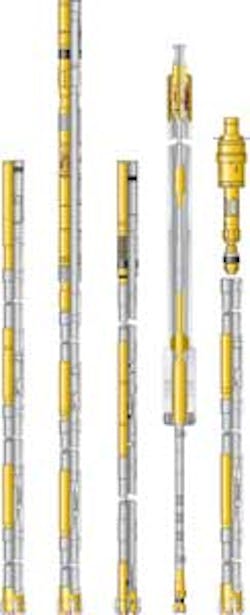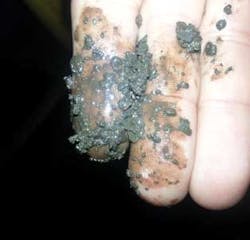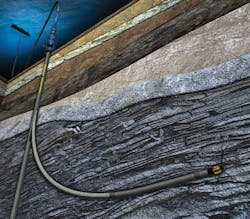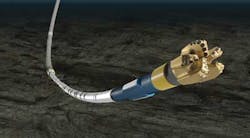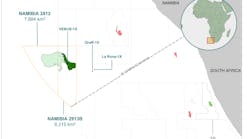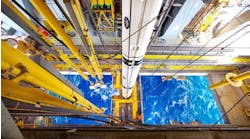Maurilio Solano
Baker Hughes
Deepwater drilling into complex reservoirs located miles below the seafloor presents common challenges to drilling contractors. Drilling through weak or lost circulation zones may prevent the liner from reaching total depth, leading to increased well construction costs and limiting the production potential of the well. These challenges may be so insurmountable by conventional drilling processes that the operator is forced to P&A the well.
The process of liner or casing drilling, in which the well's liner or casing string is used as part of the drillstring, can be a cost-effective solution that addresses many of these challenges. Liner/casing drilling is an integrated services solution that can shorten drilling time and costs, reduce non-productive time (NPT), lower the risk of drilling through trouble zones, and help ensure that the liner reaches total depth.
In standard drilling practices, an unstable formation may collapse before or after the bottomhole assembly is pulled out of hole, which may cause drillstring sticking and loss of hole gage. Drilling with liner mitigates the risks associated with unstable formations, keeps the hole protected, and allows the liner to reach its desired position. By imparting stability to the wellbore, liner drilling means that longer hole sections are possible.
Liner drilling also minimizes the risk of lost circulation if the mud weight exceeds the fracture gradient of the formation, which can cause drill pipe to get stuck, resulting in fishing jobs, side tracks, or P&A operations. Because the liner is permanently installed during drilling, lost circulation and formation damage are minimized, costs are reduced, and production rates can be higher at the outset.
Conventionally drilling through trouble zones can be challenging. The upfront analysis, pre-planning, and understanding of the reservoir are critical to success, and required to understand the geology and structure of the reservoir. Regardless of which liner drilling architecture is deployed, each system component must handle the torque and loads created during drilling operations, including rotation, reciprocation, and vibration.
At the same time, the liner drilling system must work seamlessly as part of the overall well construction. For example, the system must be compatible with the mud system to ensure the wellbore is efficiently cleaned during drilling without significant loss of mud into the formation. This is achieved through comprehensive project management and collaborative planning with both the operator and other service providers on the job.
A custom-built solution
All liner drilling assemblies have in common some type of non-retrievable casing drill shoe mounted on the end of the casing or liner. The shoe comprises polycrystalline diamond compact (PDC) cutting structures and drillable nozzles capable of either reaming to the bottom of a pre-drilled hole or drilling a new hole. It can also be drilled out by another PDC or tricone bit to allow drilling to continue in the next section. The metallurgy of the bit is selected to provide the necessary structural strength for the application's drilling parameters—weight on bit, rotary speed, and torque—to reach the section total depth. The casing bit shoe is also designed to improve the hydraulics for cuttings removal from the face of the bit, and to drill out easily with minimal risk of plugging the well or damaging the formation.
Beyond the bit, there is no "one size fits all" solution to the equipment used in a liner drilling application. Rather, the system should mirror the needs of the well, and the tools deployed depend on the complexity of the wellbore, and the geometry and geology of the reservoir. If a vertical well is to be drilled without the need for building angle, steering, or logging, a simple hydraulic balance liner drilling system can consist of a liner setting sleeve, Type I landing collar, float collar, and casing drill shoe. This is a robust system, capable of operating at higher revolutions per minute (RPMs) and for longer times down hole. However, this option does not include a top packer or liner hanger, which places an upper limit on pumping rates and circulating pressures.
When drilling into sections where higher circulation rates and pressure spikes may lead to lost circulation, the liner drilling system may be equipped with a top packer and liner hanger assembly. A liner drilling assembly that incorporates Baker Hughes' TORXS hydraulic balance expandable liner hanger system, for example, affords higher RPMs of the drill bit in combination with an expandable hanger system that allows for higher circulating pressures, better handling of pressure spikes, and a cleaner wellbore while drilling. The system incorporates ZX expandable seals to provide reliable top sealing and one-trip, two-stage setting without a plug bump. Additionally, the bypass area is another key element of liner drilling system, which allows better cleaning with improved circulation pressure.
Higher RPMs not only shorten the time required to drill the section, but also improve subsequent cementing operations. Faster rotation of the bit assures more efficient drilling through potential trouble zones to provide a wellbore with a straight and smooth profile. Higher revolutions also create smaller cuttings in a narrower size distribution for more efficient circulation out of the hole and a cleaner wellbore resulting in better cement bonding.
For other liner drilling applications, the well may require additional reservoir information through logging, which can be used to adjust the well path. This requires additional hardware on the liner assembly.
TheSureTrak steerable drilling liner is one option. It incorporates a rotary steerable system with modular logging-while-drilling and measurement-while-drilling systems. This service acquires various real-time wellbore datasets, including pressure, resistivity, gamma, neutron and density, which allow the rotary steerable system to drill continuously and change direction without slowing.
The choice of which type of liner drilling system to deploy depends upon the well's requirements, and must also account for the added risks associated with more sophisticated assemblies, and the extra costs. For example, the steerable drilling liner service option may be cost prohibitive for a liner drilling application in a vertical or deviated section of the well (where steering or logging is not required), so the driller may decide to deploy the expandable liner hanger system instead. If the liner section is shorter and deployment of the expandable liner becomes too expensive, the driller may decide to run a simpler assembly with no top packer or liner hanger.
Displaying 1/2 Page 1,2Next>
View Article as Single page
